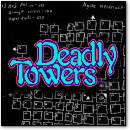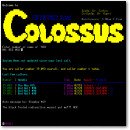[ Retro GIF of the Week ] Digitized Autumn Leaves
January 11th, 2013 by Benj Edwards Click to see other views of this image: [ Original Size ] [ 2X Zoom ]
Click to see other views of this image: [ Original Size ] [ 2X Zoom ]
From 1983 to 1996, James “Jim” Maxey operated a very successful Oregon-based BBS called Event Horizons. Through that board’s file section, Maxey made available thousands of GIF images in many categories, from landscapes to pornography, that he had created using a video digitizer board and conversion software called T-EGA.
Bob Talmadge wrote an excellent profile of Jim Maxey’s BBS years for his site BBSDays.com. I recommend reading it if you’re interested in learning more about Maxey’s BBS. Also, Jack Rickard of BoardWatch magazine mentioned Maxey’s early 1990s image-related BBS activities in an article he wrote for Wired issue 1.04 in 1993.
The early and pioneering nature of Maxey’s color graphics files for IBM PC computers ensured that his digital pictures, which he called “MaxiPics,” spread far and wide to other BBSes at the time. This is one such picture, and it depicts a house and yard in autumn. The 640 x 350 EGA format file dates from 1987 and was likely captured from a video source — more on that in a moment.
The Story of T-EGA
Most, if not all, of Maxey’s “MaxiPic” GIF images credit something called “TEGA” by Videotex Systems. There’s very little information about TEGA to be found on the Internet, so I tracked down its author, Bob Gillman of Videotex Systems. (And yes, Videotex Systems still exists, despite it being named after obsolete 1970s interactive television technology.)
Turns out it’s called “T-EGA,” and it was a 1985 commercial graphics conversion program that worked with TrueVision video capture boards on the IBM PC platform. I’ll let this detail-rich email from Bob Gillman tell the story:
[T-EGA] was my idea as to how to get “real” photo images on to the PC.
I was introduced to one of the original photo capture boards, the ICB (Image Capture Board), from AT&T labs which later became Truevision. At the time, Videotex [Systems] was the world leader in Prestel based videotex software for the PC; videotex was the transmission of text and graphics over modems. Prestel was the English videotex standard, and was a standard in many other countries like Denmark, Italy, Netherlands, Australia, etc.
AT&T was developing a NAPLPs videotex standard for the US. They used the ICB board for the NAPLPs standard, and that’s how I found out about it.
I saw the opportunity to use the board to create photo-realistic images for the PC, and that is how T-EGA was born. The “T” was for Truevision since we used a Truevision board (ICB, then later Targa), and the EGA was the output format – our highest at the time. Later, we also did VGA.
The ICB and Targa board were IBM PC compatible boards (ISA) that had a composite video input and output (like a VCR). You hooked up a video camera, and did a still image grab. You could save the image in the Targa format (TGA). T-EGA would convert either the board memory or TGA file to a file (GIF, TIF, etc.) that would display on a regular PC screen.
Later, we renamed T-EGA to ChromaTools.
Gillman emailed me some scanned brochures for T-EGA that you can download here in PDF format. He also sent me brochures for T-BASE (PDF) and ChromaTools (PDF), which were related image processing software packages.
It’s amusing today, but the role of T-EGA was simply to convert TGA format image files to GIF or PCX format while possibly resizing and converting the image’s color depth. Those features are taken for granted in our Photoshop-rich world, but T-EGA retailed for $199 in the late 1980s.
If we’re to follow logic, it looks like Maxey owned a Truevision video capture board and used it in conjunction with a video camera and likely a VCR to capture this autumn image to a PC. Then he used T-EGA to convert the resulting image into a GIF file, plopped it on his BBS, and here it is today, 26 years later.
It’s worth nothing that digitization via video capture was one of the most common ways of digitizing bitmapped images in the early years of the personal computer. It was a far more economical technology at a time when flatbed scanners cost a pretty penny (check out this Retro Scan that features a >$9,600 flatbed scanner from 1989).
I asked Gillman about Maxey and if he knew of his BBS-related imagery activities. He replied with a funny story.
Jim Maxey was one of our fans, but I did not know him personally. He loved the T-EGA program. He had a BBS and he converted images, and sold them. At one point, he asked us if we would mind him putting our company name on the images, and we thought, “Why not,” it’s some free advertising.
Well, a few months later and for years afterwards, we started getting these weird calls, like “I want to buy some of those images, you know, those dirty images.” So apparently, he was creating more than just pretty pictures of landscapes, and so on.
The maxim “sex sells” applied in the BBS world as much as it did in any other, and Maxey counted on that to fuel the success of his commercial BBS. But that’s a subject for another day. For now, have fun looking at pretty leaves.
(By the way, Jim Maxey is on Facebook these days. I have not contacted him, but I would not be surprised if he pops up one day and tells his story in the comments. Here’s hoping.)
| Retro GIF of the Week Fact Box | |
| Source File Name: | scenic1.gif |
| Source File Date: | June 20, 1988 |
| Source File Format: | GIF – 87a (non-interlaced) |
| Dimensions: | 640 x 350 pixels (EGA) |
| Color Depth: | 4-bit (16 color) |
| Origin Platform: | IBM PC |
| Derived From: | Video source |
| Creation Date: | 1987 |
| Artist: | James Maxey |
| If you know more about the origin of this image, please leave a comment. | |






January 14th, 2013 at 3:38 pm
This is very cool. What is even more funny is my mother’s phone number in Portland is is 503-777-xxxx so this BBS must have been run from somewhere in South East Portland.
We sure have come a long way since 16 color GIFs. 🙂
January 14th, 2013 at 3:40 pm
I don’t know Portland well enough to identify which park that is.
April 3rd, 2020 at 1:26 pm
You’re right, I finally showed up here years later. I am Jim Maxey of Dvent Horizon‘s BBS. And you’re right in the article / the kind of digitizing board I used to digitize in southeastPortland off of Flavel Road.
I was born in Portland and begin Event Horizons back in 1983 and went commercial in 1987. Made a lot of money. I had the first dating service online back in 1983 was it 1984. Problem was you could only have one person online at a time until multiline TBBS came out in 1987.
So much has changed and strangely here I am now living in Vietnam. I love the weather here in Da Lat, the mile high city where the temperature is always about 73° month after month all the time. And the people are civilized. So far there is no coronavirus death here. As of early morning April 4, 2020.
I was born in Portland and began Event Horizons BBS back in 1983 and went commercial in 1987. Made a lot of money.
So much has changed and strangely here I am now living in Vietnam.
Here’s my Facebook page. I change the URL a couple of years ago or so. You might want to update the link.
https://www.facebook.com/TeacherJimMaxey
my entire journey for the last 12 years is on Facebook. Thousands and thousands of images and videos.
Want to be fb friends? If you’re not a crazed Donald Trump supporter or believe we never landed on the moon, give it a try.
You can see my entire journey coming to Vietnam 3 1/2 years ago and living in the Philippines for 15 months.
And my love affair with one of the most beautiful young Vietnamese girls you can imagine. Oh my God! Her name is Vy but I called her Venus. Here’s a video I made of us and posted on YouTube:
https://youtu.be/qs3Lnh9rOF4
But now I’m the proud father of a 17-month-old half Filipino girl Who is now also a United States citizen with her on US passport. Her mother Ivy came to live with me in Vietnam before we moved together to the Philippines. I hated the Philippines. So I returned here to Da Lat Vietnam. I’ve lived in interesting life so far.
Ain’t it funny how Time slips away and what the future brings – only a fool would say.